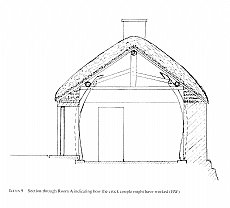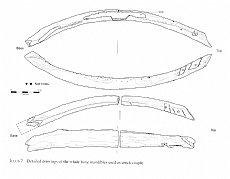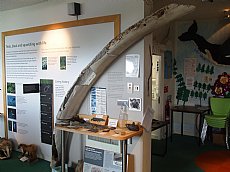Cruck Blades, Brotchies Steading, Dunnet
01 August 2019
- News Type:
- Find of the Month

© Headland Archaeology
A pair of cruck blades, also known as a ‘highland couple’, were found some time prior to 2006 in Brotchie’s Steading, a ruined croft house in Dunnet. Cruck blades were typically curved timbers joined at the top to carry the weight of a building’s roof, directly to the ground. They could either be made from single timbers or, more commonly, from several shorter lengths pinned together. The pair found at Brotchie’s Steading are therefore significant in two ways: they comprise the rarer form of single blades, and were made of whale bone rather than timber.

Initially the blades were found in three fragments. The largest was a single complete blade. Two other fragments formed the second blade, sawn in half, and together with a number of further fragments, recovered from subsequent excavation within the steading, these formed the second blade of the couple. They were identified as mandibles, likely from a Blue whale or Fin whale given their size and were in good condition. Both mandibles had been sawn off at the distal ends to shape them to the desired length, and two check lapped joints had been cut into the bone, 0.2m and 0.45m, from the sawn end. Interestingly these two joints had not been cut at the same angles indicating some complexity in the construction of the cruck yoke (see Illus 8 and 9, Holden, 2009 for diagrams). Along both blades were a series of nail holes which may have been used to fix a screen of cloth.

© Seadrift Visitor Centre, Dunnet
The use of whale bone is known from across Scotland. Smaller parts, such as vertebrae, were used for smaller objects, such as ornaments, but the larger bones, such as the mandibles, ribs and jaw bones, are known for their use in construction. They were most prised in in areas where timber was rare, such as coastal areas of the north of Scotland and the Islands, which explain the use of whale bone crucks at Brotchie’s Steading.
Since cruck framed buildings suffer rapid deterioration once they fall out of use (particularly the organic cruck frames), the crucks blades themselves are not common finds, and buildings usually only show the cruck slots where they were used. The excellent preservation of the bone crucks from Brotchie’s Steading therefore make them very rare and valuable objects for understanding and reconstructing post-medieval construction techniques. This building tradition persisted well into the 19th Century in parts of Scotland, and in the case of Brotchie’s Steading, into the 20th Century.
Further Information
The whale bone cruck blades from Brotchie’s steading are housed at the Seadrift Visitor Centre, Dunnet. For scale drawings of the cruck blades, and illustrations of their possible use, see the published 2008 PSAS article (available online from ADS).
For examples of cruck framed building from across Scotland see HES Canmore gallery
Brotchie's Steading. ARCH Site of the Month August 2019
Submitted by Grace Woolmer
Find of the Month Archive
- 25/07/2022 Steatite Vessels
- 10/04/2021 Cruisie lamp in Dunrobin Castle Museum
- 02/03/2021 Medieval Sword Pommel from Sleat, Skye
- 01/02/2021 Hilton of Cadboll Pictish Cross Slab
- 04/01/2021 Gunflint from Stoneyfield, Inverness
- 02/12/2020 Bobbin from Contin Bobbin Mill
- 02/11/2020 Russian Lead Cloth Seal from Cromarty
- 01/10/2020 The Poolewe Hoard
- 04/09/2020 Storr Rock Viking Silver Hoard
- 07/08/2020 Mesolithic bloodstone artefacts from Camas Daraich, Skye
